|
Artega GT
Debut: 2008
Maker: Artega
Predecessor: no |
|
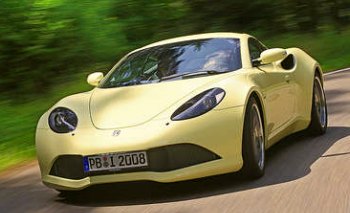
|
New German sports car wants to beat
Porsche
|
Recently I observed a
trend: the
world’s center of sports car specialists is gradually shifting from UK
to Germany. Back up by the performance engines and components from BMW
and Volkswagen group, new German sports car makers like Wiesmann
started getting the attention of the world. The latest entry
is Artega, a subsidiary of German electronic components maker Paragon.
Paragon produces mainly in-car multimedia, instrumental and climate
control systems. But its boss Klaus Dieter Frers is interested in
producing sports cars as well. He established Artega in Northern German
city Delbruck (not far from Volkswagen’s Wolfsburg), hired ex-Aston
Martin design chief Henrik Fisker and ex-Porsche engineer Hardy Essig
to design his first car, Artega GT. Priced at 75,000 Euro, this car is
more expensive than Porsche Cayman S (60,000 Euro) and closer to the
territory of the base 911 Carrera (80,000 Euro). Some might question
how a new sports car company without racing or prestige pedigree could
be dare to compete with Porsche directly. Well, Mr. Frers is not too
greedy. He plans to sell only 100 cars this year and eventually rise to
500 cars a year from 2010. The market should easily accommodate it.
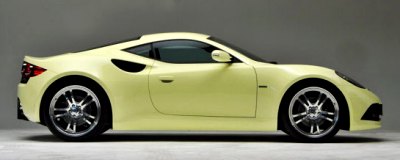
|
It weighs only 1100 kg, some 200 kg
lighter than Cayman S...
|
The Artega GT
is best
compare to Porsche Cayman S. Both are mid-engined sports cars and
powered by a 6-cylinder engine. However, the Artega has a much sportier
profile – much shorter, wider, lower yet runs a slightly longer
wheelbase. Its big, 19-inch wheels and fat tires are pushed to the
corners to deliver an immensely stable appearance. Its curvy bodyshell
looks more muscular, energetic yet compacter than the Porsche. Unlike
the mass production Porsche, it is made of exotic lightweight
materials. The bodyshell is carbon-fiber reinforced composites. The
chassis comprises of welded aluminum tub, aluminum spaceframe front
structure, tubular steel rear structure and tubular steel roof rails.
It weighs only 1100 kg, some 200 kg lighter than Porsche. Suspensions
are double-wishbone type at all corners, another advantage against the
all-strut setup of Porsche.
Mounted transversely at the tubular steel rear chassis is a Volkswagen
narrow-angle V6 and 6-speed DSG gearbox. They come directly from Passat
R36. The 3.6-liter 24-valve twin-VVT engine produces 300 horsepower and
258 lb-ft in stock form, abundant for the 1100 kg sports car so that
any tuning is considered unnecessary. Artega claims 168 mph top speed
and 0-60 mph in less than 4.8 seconds, which is totally believable.
Such performance level is well matched with its price – faster than
Cayman S and slower than 911 Carrera – though not as much performance
bargain as British and American sports cars.
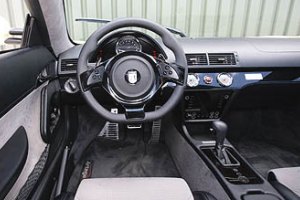
|
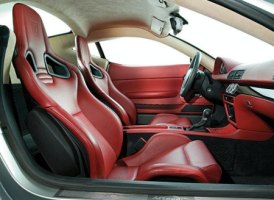
|
For a low volume sports car, it is
very well built and engineered...
|
However,
the
German car excels in build quality. We are not talking about Porsche
level of build quality, but for such a low volume sports car, it is
very well built and engineered indeed. Although its cockpit is not very
stylish or luxuriously trimmed, it has the basics made right. For
example, excellent driving position, supportive bucket seats and
well-judged control weightings. It also gets an electronic instrument
and control system purposely developed by Paragon, something other low
volume sports car specialists couldn’t hope for. Despite of its low
height, its low-mounted seats enables surprising amount of head room,
while the narrow transmission tunnel frees up elbow room. This cabin
feels roomier than it appears to be. Behind the seats is a luggage
space measuring 225 liters, in addition to the 75-liter front boot, it
is nearly as practical as Porsche.
Nevertheless, the best of Artega GT is how it drives. Start the motor,
it exhaust note sounds like a small-capacity V8. The Volkswagen
long-stroke V6 has a wide torque band, as shown by its flat torque
curve peaking from 2400 to 5300 rpm. Coupling to its lightweight, the
Artega feels much more energetic than Cayman S. Its paddle-shift
double-clutch gearbox is typically responsive, smooth and enjoyable to
use.
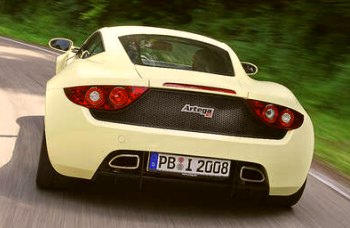
|
It is hard to imagine how a German
machine could deal with uneven roads so good, especially at the same
time it excels in high-speed stability...
|
In
corners,
you can feel its low center of gravity through the rock steady
cornering. The massive tires (235/35ZR19 front and 285/30ZR19 rear)
provide excellent grip and put the Artega on rails. The steering is
lightweight yet razor sharp and genuinely communicative, something only
the best-tuned mid-engined machines could achieve. It drives like a
more powerful version of Lotus Elise. In other words, sportier and more
responsive than Cayman S. The chassis feels rock-solid as the
suspensions soak up ruts and bumps on B-roads beautifully. It is hard
to imagine how a German machine could deal with uneven roads so good,
especially at the same time it excels in high-speed stability.
The Artega GT is really amazing on the road. It makes Porsche Cayman S
feel soft and ordinary. So the new comer has the giant knocked out ?
Not exactly. Porsche still holds a quality standard and reliability
records that low volume sports car specialists unable to match. Though
well engineered for its kind, Artega GT is not as polished or as
refined as Porsche. Moreover, not many people would pay the same price
of a 911 for an unknown sports car. That said, Rome was not built in
one day. If Artega keep producing cars as good in the coming years, it
might just become another Porsche.
|
| The
above report was last updated on 10 Oct 2008. All Rights Reserved. |
|
|


